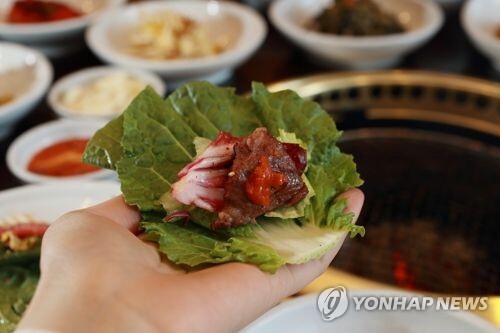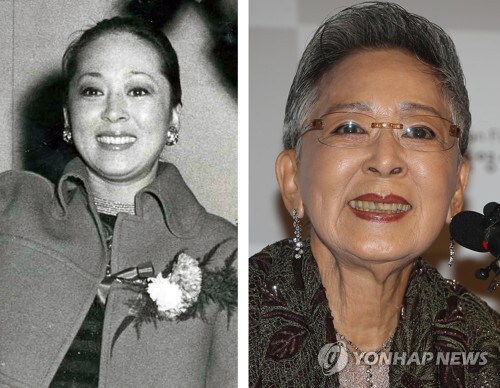by Ra Hwak Jin / Cha Min Kyung
[ENG] Ssam in English means 'wrapped' and usually refers to a Korean dish where leafy vegetables are used to wrap a piece of meat.
 |
| ▲ In this file photo, taken on Mar. 17, 2017, shows a representative presentation of "Ssam" where meat dipped in "ssamjang" is placed in lettuce and wrapped altogether. (Yonhap) |
"Ssam," refers to a Korean dish that is usually enjoyed by wrapping a piece of meat or various fillings in leafy vegetables such as lettuce, cabbage, and Perilla leaves. In some cases, the fillings are wrapped in sliced radish or seaweed. The word Ssam is also used to call the vegetables, such as lettuce, dried seaweed, and Chwinamul (a Korean fragrant leaf vegetable), used to create the wrap or the actual food that fills the wrap.
However, "Ssam" also entails different meanings that do not connect with the Korean dish. For instance, the Korean title of the KBS drama "Fight For My Way" (2017), starring Park Seo-joon, is "Ssam My Way." Here, the word "Ssam" does not mean a wrap but is a shortened pronunciation of the Korean word, '싸움·[ssa-um],' which translates to 'fight' in English.
◇ Where does the origin of "Ssam" stem from?
Ssam has been Korea's favorite food since at least the Goryeo Dynasty (A.D. 918-1392). According to the Encyclopedia of Korean Culture by the Academy of Korean Studies, Yang Yun-fu's poem, written during the Yuan Dynasty, notes how the people of Goryeo eats Ssam or rice wrapped in vegetables, which give off a pleasant smell.
During the Joseon Dynasty, various documents, including scholar Yu Mong-in (1559-1623)'s Eou yadam (1762-1836) and poet Jeong Yak-yong's "Dasan" poem collection (1762-1836), describes people enjoying rice inside lettuces with soybean paste or red pepper paste. Some trace the origin of Ssam back to the Three Kingdoms period based on artifacts excavated from the Cheonmachong tomb built during the Silla Dynasty.
| ▲ This photo, captured from Hamzy's "mukbang" or "eating show" video, shows the YouTuber enjoying the Ssam dish. (PHOTO NOT FOR SALE) (Yonhap) |
Recently, controversy arose over Chinese netizens' claiming that Ssam originated from China. Earlier this year, Hamzy, a famous Korean "mukbang" YouTuber, denied Chinese citizens' claims of saying Korean food such as kimchi and ssam are Chinese traditional foods. "I believe Kimchi and Ssam are definitely part of Korean food. It is absurd that such controversies are even emerging." Since then, a Chinese agency for popular "eating shows," terminated its contract with Hamzy and deleted the YouTuber's video clips.
◇ The globalization of "Ssam"
As Ssam is a combination of vegetables and meat, which is also accompanied by a sauce called "ssamjang," it is visually appetizing and tasty. When TV entertainment programs and dramas want to portray people eating plentiful of foods, it often shows people eating Ssam. It is also a cliché way used between parents, couples, or close friends to show off their tight bonds by wrapping a Ssam and feeding it to each other.
This dish is also one of the representative Korean foods to be widely known as the Korean Wave or "Hallyu" and has begun to spread globally. However, in foreign Korean restaurants, since the method of creating a Ssam may be unfamiliar to foreigners, the chefs usually wrap the Ssam beforehand and serve the dish like spring rolls.
Ssam was also one of the focused recipes at the "2021 K-Food Weekend," an experiential event held by the U.S. regional headquarters of the Korea Agro-Fisheries and Food Trade Corporation (aT) to inform American consumers of Korean agricultural products.
| ▲ This photo, captured from the Korea Agro-Fisheries and Food Trade Corporation (aT) website, shows the event held with former K-pop idol member of U-Kiss, Kevin Woo, for the '2021 K-Food Weekend. (PHOTO NOT FOR SALE) (Yonhap) |
At the event, Kevin Woo, a former member of K-pop idol group U-Kiss and Korean-American singer-songwriter, presented various ways to easily enjoy Korean Ssam and barbecue at home through Instagram's live broadcast.
Kevin Woo also proposed an "#Awe-Ssam" challenge event to encourage participants to experience the Ssam culture at home.
Local governments in Korea are also taking the lead in introducing Ssam.
Gwangju City in Gyeonggi Province, where lots of vegetables are grown, declared the 31st of every month to be "Ssam Day" and created a YouTube contest called "My Own Happy Ssam Story" to promote the particular dish.
 |
| ▲ This photo, provided by Gwangju City, shows one of the contestant contents for the YouTube contest "Ssam Story." (PHOTO NOT FOR SALE) (Yonhap) |
"Ssam Day" is said to have been decided on the 31st since "Ssam" has a similar pronunciation to '삼·[sam],' which refers to the number 'three' in Korean, and one, in hopes that this day will bring everyone as "one."
(END)
(C) Yonhap News Agency. All Rights Reserved













![[가요소식] 지코, 요아소비 이쿠라와 신곡 '듀엣' 발매](https://korean-vibe.com/news/data/20251212/yna1065624915953509_920_thum.jpg)









